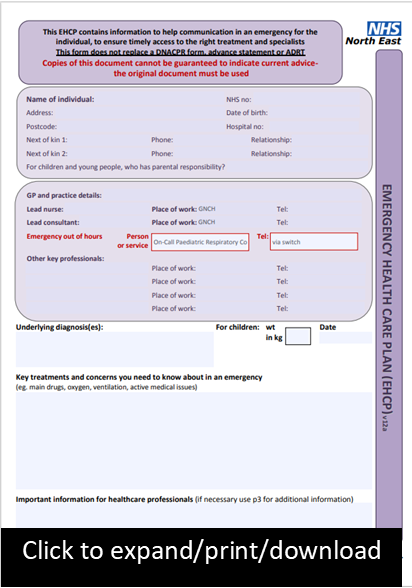Emergency care for child with a tracheostomy fitted
This page has been specifically written for parents/carers whose child has a tracheostomy fitted and have or will be trained by a team of professionals on how to care for their child at home.
It is essential your child’s tracheostomy tube remains in place and clear of secretions or any blockages at all times. We know emergency situations can happen, which you will be trained to manage before leaving hospital for the first time. These can be frightening, but your medical and nursing teams will make sure you have had many chances to practice and are confident in managing them safely until an ambulance arrives, if needed.
Quick links to guides in an emergency
- How do I know if my child's tube blocked
- What do I do if my child's tracheostomy tube is blocked
- Accidental removal of the tracheostomy tube
- Difficulty inserting the tracheostomy tube guide with videos
- Emergency Health Care Plan
- If your child (with a tracheostomy tube fitted) has a fever (opens a new page)
Tracheostomy tubes and colds/coughs
When your child has a cough or cold they may have thicker secretions and need more suctioning than usual. Making sure there is enough humidity around will help prevent your child’s secretions drying out and hardening within the tube. Keeping them well hydrated (drinking plenty) will help stop secretions becoming too thick.
If your child’s secretions are thicker or a different colour you may need to arrange to send a sample of secretions to check if they have a bacterial infection and need antibiotics or not. Please contact your airway specialist or community nursing teams to arrange this.
Tube blockage
How do I know if my child’s tracheostomy tube is blocked?
If your child has a blocked tube, they will find it difficult to breathe. Look out for these signs:
- Noisy breathing and secretions you can hear in their tracheostomy tube
- Making uncomfortable breathing noises
- Breathing faster than usual
- Sucking in of their chest wall (below or between their ribs), or neck, (below the site of the tracheostomy)
- Appearing distressed, frightened or uncomfortable breathing
- Sweating or pale skin
- Feeding less than normal
- Drop in oxygen saturations identified on their monitor
What do I do if my child's tracheostomy tube is blocked
- Suction the tracheostomy tube to make sure there is no mucus plug. Do not try to force a suction catheter through the tube against resistance. This risks pushing any blockage further down the tube.
- If your child’s symptoms do not improve quickly or you are unsure if the tracheostomy tube is blocked, change the tracheostomy tube. Use the emergency tracheostomy tube already prepared in your tracheostomy box.
- If your child still does not improve and you are still concerned call 999. Tell the call handler your child has a tracheostomy tube.
- If at any point your child has stopped breathing, begin Basic Life Support by performing rescue breaths.
Basic life support (BLS) infant
Basic life support (BLS) child
Accidental removal of tracheostomy tube
If the tracheostomy tube falls out it needs to be replaced immediately.
- Ideally use a clean tube and ties.
- You should always have a spare tube (the same size) already prepared in your tracheostomy box in case of need for emergency replacement.
- If a spare tube is not available, you will need to put the old tube back in. Remember to put the introducer into the old tube and use some lubricant. When you can replace with a clean tube.
Remember to always remove the introducer after the tube has been inserted and secure the tube and ties.
If your child is not responding normally or in the event you are unable to replace a tracheostomy tube, you should seek immediate help by calling 999.
If you are concerned your child has stopped breathing begin Basic Life Support giving rescue breaths.
Basic life support (opens new page)
Difficulty inserting tracheostomy tube
If at any time you are unable to insert your child’s usual tracheostomy tube:
- Use the smaller (downsize) tube available in your tracheostomy box which is a half size smaller.
- If you can’t insert the smaller tracheostomy tube, call an ambulance. Tell them your child has a tracheostomy.
- Begin Basic Life Support. There is a slight difference in this depending on whether your child has a red or blue tracheostomy box. Please watch the correct video below for your child.
Difficulty inserted a tracheostomy in a child with a RED BOX
Difficulty inserting a tracheostomy in a child with a BLUE BOX
Emergency Health Care Plan
If your child has a tracheostomy as well as other healthcare needs they should have an Emergency Health Care Plan (EHCP). This plan helps everyone know how to look after a child in an emergency, because all of the important information is in one place and easy to find. It is written for healthcare professionals.
Your child's EHCP includes agreed levels of care and specific treatments that your child may need. The EHCP is an agreement about the best care for your child, between the child (wherever possible), parents and/or carers and the lead health professional (usually a consultant paediatric doctor). The views of other team members such as nurses, the general practitioner or other allied health professionals, who know your child well, may also be considered.
An example of the format of an EHCP is given below:
Not all emergency situations can be predicted and included in an EHCP. When in place an EHCP should always be considered, however there may be unforeseen situations for which a doctor treating your child will need to make his or her own clinical judgement.
At all times carry your EHCP with your child.



